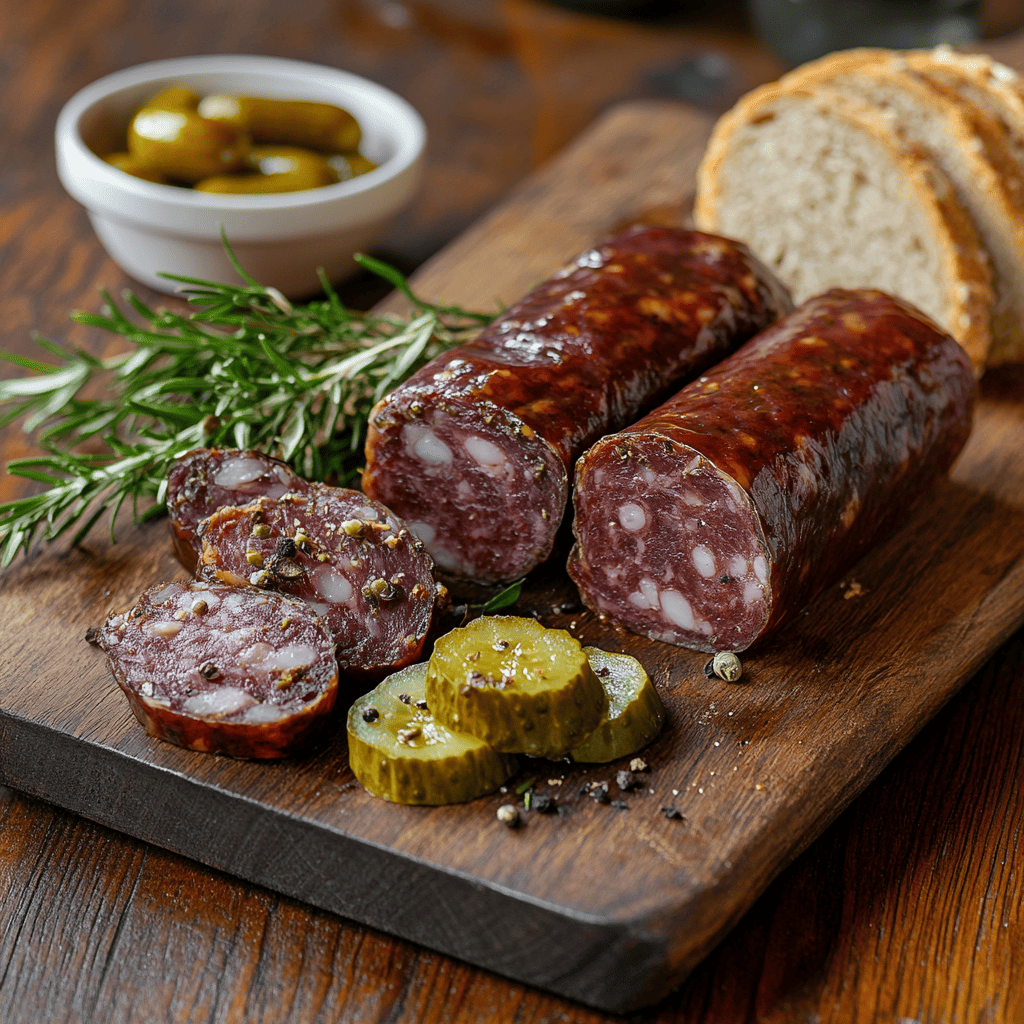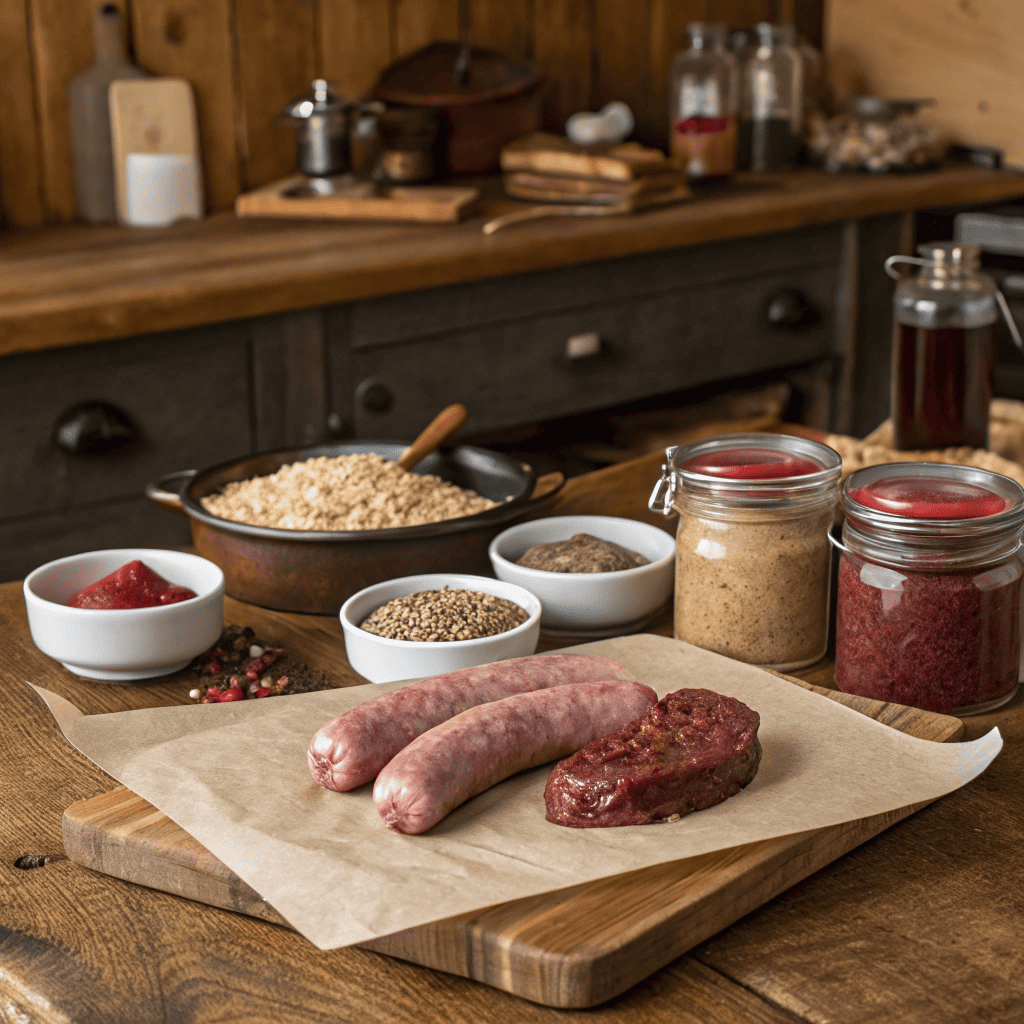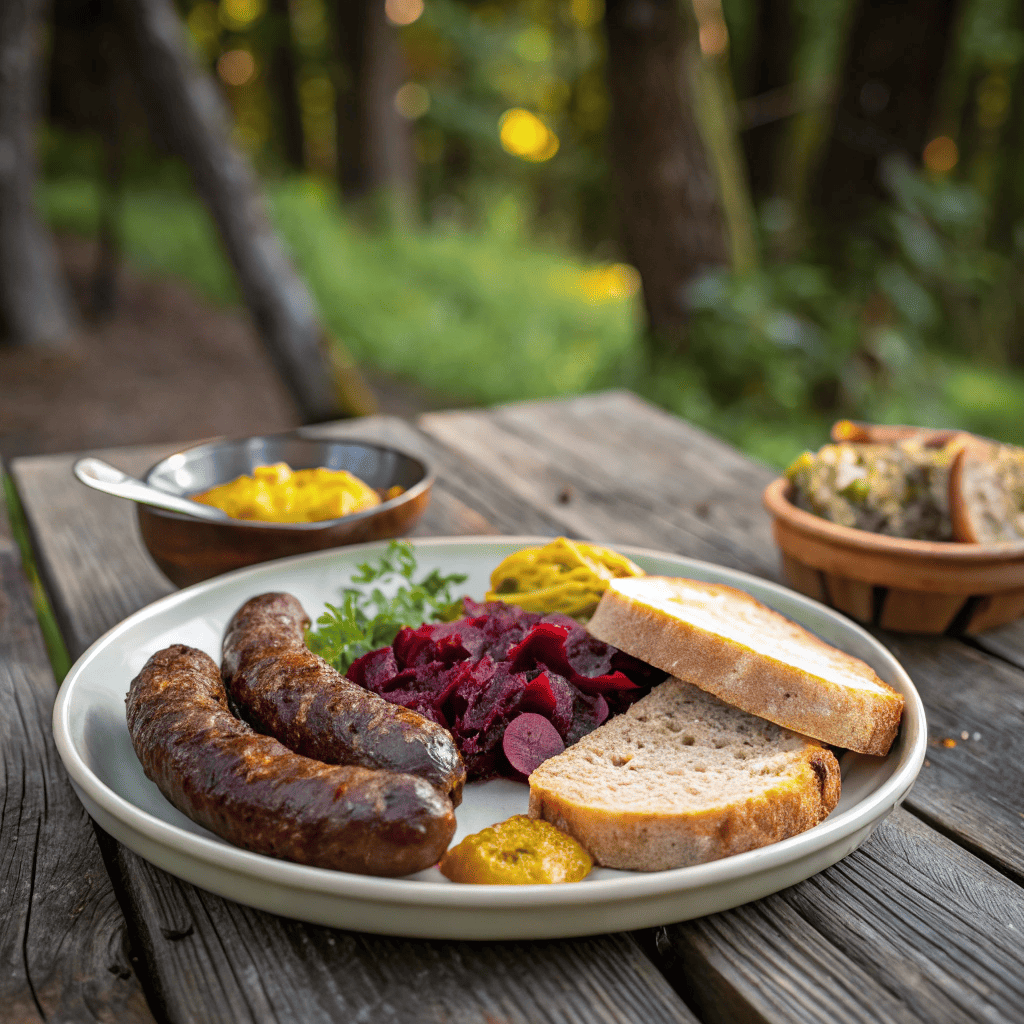Blood Tongue Sausage: A Bold Slice of Heritage on Your Plate
There’s something deeply comforting about recipes that whisper of old country kitchens and generations past. Blood tongue sausage—Zungenwurst, as the Germans call it—is one of those traditions that feels both ancient and alive. For folks like us who believe in using the whole animal and cooking with intention, blood tongue sausage isn’t just a dish—it’s a way of life. In this article, we’ll dive into what blood tongue sausage really is, why it’s perfectly legal (and delicious) in the U.S., and how to serve it at home with pride. Whether you’re homestead curious or reclaiming old-world flavors, this sausage deserves a spot on your plate.

Table of Contents

Blood Tongue Sausage: Bold Heritage Brought to the Table
- Total Time: 15 minutes
- Yield: 4 servings
Description
A traditional German-style sausage made with pig’s blood, pickled beef tongue, oats, and spices. Fully cooked and rich in flavor, it’s a rustic, satisfying dish that can be served cold or pan-fried.
Ingredients
-
Pig’s blood
-
Pickled beef tongue
-
Oats or breadcrumbs
-
Suet (pork or beef fat)
-
Black pepper
-
Marjoram
-
Salt
-
Pig’s blood
-
Pickled beef tongue
-
Oats or breadcrumbs
-
Suet (pork or beef fat)
-
Black pepper
-
Marjoram
-
Salt
Instructions
Instructions:
-
Slice the blood tongue sausage into thick rounds.
-
Pan-fry in butter or bacon fat until the edges are golden and slightly crisp.
-
Serve warm with mustard, pickled vegetables, or potatoes.
-
Alternatively, enjoy cold on rye bread with horseradish or mustard.
-
Store leftovers tightly wrapped in the refrigerator for up to 7 days.
Notes
Notes:
-
Use a sharp knife for clean, even slices.
-
Freezes well when vacuum-sealed.
-
Great with braised red cabbage or fermented kraut.
- Prep Time: 5 minutes
- Cook Time: 10 minutes
- Category: Pan-fry or cold serve
- Method: German-American
- Cuisine: Main / Traditional
Nutrition
- Serving Size: 2–3 slices
- Calories: 220
- Sugar: 0g
- Sodium: 480mg
- Fat: 18g
- Saturated Fat: 7g
- Unsaturated Fat: 9g
- Trans Fat: 0g
- Carbohydrates: 6g
- Fiber: 0g
- Protein: 10g
Keywords: blood tongue sausage, Zungenwurst, German blood sausage, traditional sausage recipe, how to eat blood sausage, pickled beef tongue, homestead sausage, pan-fried sausage, nose-to-tail recipe, rustic sausage dish
Where Tradition Meets the Table
Grandma’s Butcher Paper Bundles
I remember the first time I saw blood tongue sausage, wrapped in waxed butcher paper and tucked in the corner of a Polish deli upstate. The man behind the counter called it “head cheese’s fancy cousin.” My grandmother would’ve known exactly what it was—probably made it in her own kitchen more than once. She had a way of turning the bits most folks would toss aside into something rich and satisfying. That’s what blood tongue sausage is. A mosaic of flavor and thrift—tender cubes of pickled tongue suspended in a dark, earthy blend of blood, fat, and grain. It might sound unusual to some, but back when nothing went to waste, this was prized comfort food. And if you’ve ever simmered venison low and slow or canned tomatoes ‘til the lids popped, you know the feeling.
What Makes Blood Tongue Sausage Unique
Unlike your typical sausage link, blood tongue sausage is built on boldness. It’s made from pig’s blood, beef tongue, suet, and often oats or breadcrumbs—nothing fancy, just real ingredients with purpose. The blood lends a rich, iron-forward depth, while the tongue adds texture and a mellow, savory bite. Often sold pre-cooked, it’s perfect sliced cold on rye bread or crisped up in a cast iron skillet for breakfast. If liverwurst and scrapple are cousins, this one’s the tough, flavorful uncle with stories to tell. I like mine seared, laid over sourdough with a swipe of mustard and some pickled onions from the pantry—flavors that make you pause, chew slow, and remember where you came from.
Understanding the Ingredients & History

What Is Blood Tongue Made Of?
At its heart, blood tongue sausage is a recipe that honors the whole animal. Traditional recipes use pig’s blood, pickled beef tongue, suet (which is rendered beef or pork fat), oats or breadcrumbs, and a touch of spice—usually black pepper, marjoram, or allspice. These simple, hearty ingredients come together to form a deeply flavored sausage that’s both rich and satisfying. The pickled tongue isn’t just for texture—it adds a bright, tangy note that keeps the sausage from becoming too heavy.
Here’s how blood tongue sausage compares to other popular blood-based sausages:
Sausage Comparison Table
| Sausage | Main Ingredients | Texture |
|---|---|---|
| Blood Tongue Sausage | Pig’s blood, pickled beef tongue, oats, suet | Firm, with tongue chunks |
| Black Pudding (UK) | Pig’s blood, oats, barley, fat | Soft, crumbly |
| Morcilla (Spain) | Pig’s blood, rice, onion | Dense, spicy |
These sausages may vary by region, but they share one thing in common: resourcefulness. If you’ve ever put up lard-rendered onion jam or made your own smoked venison sausage, then you already understand the spirit of using every part of the harvest.
The History Behind This Bold Bite
Blood tongue sausage isn’t just food—it’s food with a story. It traces its roots to rural Germany, where families relied on butchering animals seasonally and preserving every scrap. After a pig was slaughtered in the fall, the fresh blood would be whisked and mixed quickly with warm fat, grains, and tongue, then stuffed into casings and poached until firm. This ensured that nothing was wasted, and the sausage would keep through the colder months.
When German immigrants settled across the U.S.—especially in areas like Pennsylvania and Wisconsin—they brought these traditions with them. To this day, you can find blood tongue sausage in certain ethnic markets and old-school butcher shops that still honor these recipes.
For the homesteader, it’s more than a deli meat. It’s a living link to those who made do with what they had—and made it taste good. If you’re already someone who cures homemade salami or pressure cans root vegetable stews, then you’re right at home here.
Answering the Big Questions Clearly
Is Blood Sausage Illegal in the U.S.?
One of the most common questions people ask is whether blood sausage is even allowed in the U.S. The short answer: yes, blood tongue sausage is legal to sell, buy, and eat. However, not all varieties make it through the import process. For example, traditional British black pudding often contains sheep lungs, which are banned by the USDA. That’s why you won’t find many authentic imports on grocery store shelves. But when made domestically—like most blood tongue sausage in the U.S.—it’s perfectly legal and sold in specialty meat shops, especially in areas with strong German or Eastern European roots.
In fact, if you’re sourcing from your local butcher or making your own sausage during hog butchering season, you’re continuing a long-standing tradition that’s completely allowed by food safety laws. The key is using USDA-approved ingredients and preparation practices. Just like when you safely can homemade bone broth, the safety comes from proper handling and storage—not the ingredient itself.
Is Blood Sausage Safe to Eat?
Yes, it’s safe—when properly prepared. Blood tongue sausage is almost always fully cooked before it ever reaches your plate, and it doesn’t require any additional cooking unless you want to warm or brown it. The blood used is typically collected during the butchering process in a clean environment, mixed with hot fat, and brought to a safe internal temperature during cooking.
Nutritionally, blood sausage is rich in protein and iron, and contains B vitamins like B12. That said, it’s not an everyday food for most folks. It’s also high in saturated fats and sodium, which means it’s best enjoyed in moderation—think of it the way you would cured bacon or salami.
For homesteaders, it fits naturally into a diet that already leans on preserved meats, pickled vegetables, and whole ingredients. If you’ve already mastered canning wild mushroom ragout or crafting smoked head cheese, you likely already know how to handle, store, and enjoy traditional foods like this safely.
Blood tongue sausage might look intense to someone used to plain deli ham, but when made with care and eaten with intention, it’s as safe as any meat product—just a bit more soulful.
From Skillet to Board – Ways to Enjoy It

How Do You Eat Blood and Tongue Sausage?
If you’re new to blood tongue sausage, the first bite might surprise you—in the best way. It’s sold pre-cooked, so you can eat it cold straight from the deli slice or warm it gently in a skillet until the edges crisp. The marbled slices hold their shape well, making it a solid addition to a charcuterie board or as the star of a rustic breakfast.
Here’s how I serve it on our homestead:
- Pan-fried: Slice it thick and brown in butter or bacon drippings until the outside is golden and slightly crisp.
- Cold: Serve chilled with strong mustard, pickled onions, and rye bread. It pairs beautifully with homemade mustard pickles.
- On a sandwich: A few thick slices with horseradish mayo and some sauerkraut between crusty bread makes a hearty lunch.
- With potatoes: Add slices to a plate of pan-fried garden potatoes and call it supper.
Whether you’re eating it as a quick snack or building a meal around it, blood tongue sausage holds up well and doesn’t need much fuss.

Homestead Tips for Serving & Storing
Like many traditional meats, blood tongue sausage was designed to last. Kept wrapped in parchment and refrigerated, it stays good for up to a week. If you’re buying a whole piece from the butcher, ask for it vacuum-sealed so you can keep extras in the freezer for longer storage. Once opened, slice what you need and press plastic wrap against the exposed cut to keep it fresh.
When it comes to pairing, go with what’s already in your pantry or garden. Root vegetables, fermented kraut, spicy mustard, and even a crisp apple all bring balance to the richness of the sausage. In colder months, I like to serve it with a side of warm braised red cabbage—the sweet acidity works wonders.
You don’t need to reinvent your kitchen to enjoy blood tongue sausage. If you’ve got a cast iron skillet, a cellar of canned veggies, and a loaf of hearty bread, you’ve already got everything you need. Like most old-world dishes, it fits right into the rhythm of a home where food is real, seasonal, and made with care.
Conclusion: Bringing Back a Forgotten Flavor
Blood tongue sausage might not be something you find at the corner store, but for those of us who value heritage recipes, whole-animal cooking, and deep, honest flavor—it’s a treasure. Whether you grew up with it or just stumbled across it at your local butcher, it deserves a place on the table.
If you’re someone who already keeps a pantry full of canned vegetables, smokes your own meats, or makes soup stock from scratch, then this sausage fits right in. It’s not trendy—it’s timeless. And in a world that too often forgets where food comes from, dishes like this help us remember.
So go ahead—slice it, fry it, share it. Add a dollop of mustard, a few pickled beets from your shelf, maybe even a cold beer. Let it remind you of who you are and where your kitchen heart truly lies.
📌 Follow along or tag me here:
Facebook: Recipes NYC on Facebook
Pinterest: @Recipes_NYC on Pinterest

